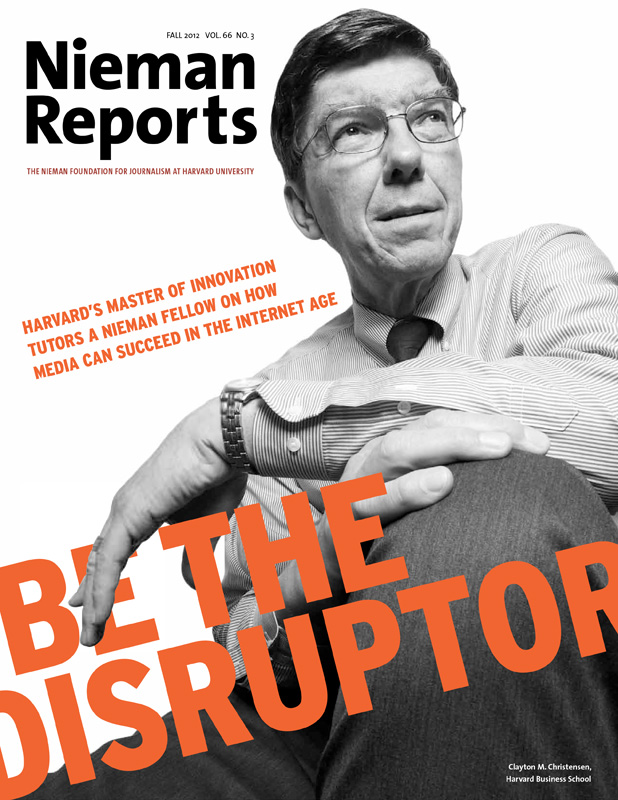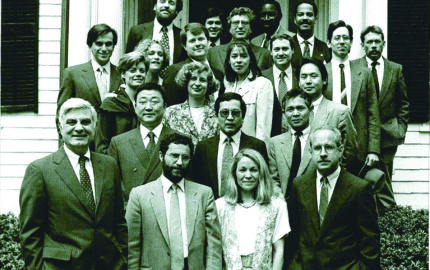Journalism is an escape artist.
For the generation raised on Watergate, that lesson landed hard. The most powerful men in the world could not shut a story down. They lied and conspired, then bullied the watchdogs, but the facts prevailed, coaxed into daylight by journalists. I doubt I was the only teenage girl to draw special inspiration from Washington Post publisher Katharine Graham, who endured a thuggish threat from the Nixon administration and didn’t blink.
“All that crap, you’re putting it in the paper? It’s all been denied,” former U.S. Attorney General John Mitchell told reporter Carl Bernstein. “Katie Graham’s gonna get her tit caught in a big fat wringer if that’s published.”
The years following Watergate did not shake my belief in journalism’s inevitability, even when journalists were slow off the mark or challenged by the most extreme conditions. I thought of this anew when the 2012 Nieman Fellows chose their winner for the annual Louis M. Lyons Award for Conscience and Integrity in Journalism, named for the late Nieman curator. The honor went to Mohammed “Mo” Nabbous, founder of Libya Alhurra TV, who succeeded in bypassing government blocks on the Internet in order to stream live footage and commentary about Libyan unrest.
While disseminating those first images of the Muammar el-Qaddafi regime’s clashes with rebels and attacks on civilians, Nabbous was shot and killed. His wife announced his death on the very live stream that Nabbous had created.
Journalism is an escape artist.
Bullets and political threats are not journalism’s only predators. The avarice and ignorance of some owners have played their part. So too the fabulists and cheats who would lay low their newsrooms by breaking the trust. But the collapse of the business model that long sustained the industry has come to overshadow those worries. The fundamentals are broken and alternatives are uncertain. How does journalism escape this?
In this special issue of Nieman Reports, we examine that question through the eyes and research of one of Harvard’s preeminent scholars, business school professor Clayton M. Christensen. Christensen’s groundbreaking research on innovation and disruption, documented in his book “The Innovator’s Dilemma: When New Technologies Cause Great Firms to Fail,” has influenced some of the world’s most successful entrepreneurs.
How Christensen came to focus on the news industry is a story that underscores the fundamental promise of a Nieman Fellowship. When Canadian journalist David Skok arrived at Harvard last year, he joined 24 other journalists from around the world in a tradition of study dating to 1938. But the tremulous business environment in which he and other fellows operate has brought a new urgency to the work of the Nieman Foundation.
Skok knew of Christensen’s examination of industries ranging from education to health care and wondered: Why not layer the lessons onto the upheaval in journalism? Christensen agreed and the fruits of their collaboration are documented in these pages and as an e-book found on the Nieman Reports website.
Their conclusions, Skok writes, will not alone eliminate the challenges that haunt modern media companies. Nor should their consumer-centric framework be confused as a substitute for the journalism of accountability. But the clear questions they pose—about culture, organization, habits and risk—are provocative ones that can enlighten decisions in individual news organizations and the industry more broadly.
Without a business plan, Skok says, “there is no editorial independence left to root for,” a truth from which there can be no escape.
For the generation raised on Watergate, that lesson landed hard. The most powerful men in the world could not shut a story down. They lied and conspired, then bullied the watchdogs, but the facts prevailed, coaxed into daylight by journalists. I doubt I was the only teenage girl to draw special inspiration from Washington Post publisher Katharine Graham, who endured a thuggish threat from the Nixon administration and didn’t blink.
“All that crap, you’re putting it in the paper? It’s all been denied,” former U.S. Attorney General John Mitchell told reporter Carl Bernstein. “Katie Graham’s gonna get her tit caught in a big fat wringer if that’s published.”
The years following Watergate did not shake my belief in journalism’s inevitability, even when journalists were slow off the mark or challenged by the most extreme conditions. I thought of this anew when the 2012 Nieman Fellows chose their winner for the annual Louis M. Lyons Award for Conscience and Integrity in Journalism, named for the late Nieman curator. The honor went to Mohammed “Mo” Nabbous, founder of Libya Alhurra TV, who succeeded in bypassing government blocks on the Internet in order to stream live footage and commentary about Libyan unrest.
While disseminating those first images of the Muammar el-Qaddafi regime’s clashes with rebels and attacks on civilians, Nabbous was shot and killed. His wife announced his death on the very live stream that Nabbous had created.
Journalism is an escape artist.
Bullets and political threats are not journalism’s only predators. The avarice and ignorance of some owners have played their part. So too the fabulists and cheats who would lay low their newsrooms by breaking the trust. But the collapse of the business model that long sustained the industry has come to overshadow those worries. The fundamentals are broken and alternatives are uncertain. How does journalism escape this?
In this special issue of Nieman Reports, we examine that question through the eyes and research of one of Harvard’s preeminent scholars, business school professor Clayton M. Christensen. Christensen’s groundbreaking research on innovation and disruption, documented in his book “The Innovator’s Dilemma: When New Technologies Cause Great Firms to Fail,” has influenced some of the world’s most successful entrepreneurs.
How Christensen came to focus on the news industry is a story that underscores the fundamental promise of a Nieman Fellowship. When Canadian journalist David Skok arrived at Harvard last year, he joined 24 other journalists from around the world in a tradition of study dating to 1938. But the tremulous business environment in which he and other fellows operate has brought a new urgency to the work of the Nieman Foundation.
Skok knew of Christensen’s examination of industries ranging from education to health care and wondered: Why not layer the lessons onto the upheaval in journalism? Christensen agreed and the fruits of their collaboration are documented in these pages and as an e-book found on the Nieman Reports website.
Their conclusions, Skok writes, will not alone eliminate the challenges that haunt modern media companies. Nor should their consumer-centric framework be confused as a substitute for the journalism of accountability. But the clear questions they pose—about culture, organization, habits and risk—are provocative ones that can enlighten decisions in individual news organizations and the industry more broadly.
Without a business plan, Skok says, “there is no editorial independence left to root for,” a truth from which there can be no escape.




